 |
|
|
| Principal author(s): Page created: Page last updated: (Information by Peter Kessler and David Ross, with additional information by Edward Dawson, from The Horse, the Wheel, and Language: How Bronze-Age Riders from the Eurasian Steppes Shaped the Modern World, David W Anthony, from The Arzawa Letters in Recent Perspective, J David Hawkins (British Museum Studies in Ancient Egypt and Sudan 14 (73-83, 2009)), from Hittite Diplomatic Texts, Gary Beckman (Second Ed, Scholars Press, Atlanta, 1999), from The Kingdom of the Hittites, Trevor Bryce (1998), from The Hittites, O R Gurney (1991), from Annals of Mursili (Years 1 to 8), Ian Russell Lowell, from The Hittites, J G Macqueen (1996), from Hittite Prayers, Itamar Singer (Scholars Press, Atlanta, 2002), and from External Links: Indo-European Chronology - Countries and Peoples, and Indo-European Etymological Dictionary, J Pokorny, and Anatolian Conference abstracts, Emory University, and The alleged kingdom of the disappeared Hittites is found (Free News), and Proto-Bulgarian Runic Inscriptions, and Linguistics Research Center (University of Texas at Austin).) |
|
|
| c.1370 BC |
Stronger than Hittite King Tudhaliya IV (III), Tarhunta-Radu of Arzawa redraws his frontier to a line between Tuwanuwa and Tyana, a hundred miles to the south of Hattusa, and along to Uda. With the king being a contributor to the [ Egyptian](../KingListsAfrica/EgyptAncient.htm#The New Kingdom) Amarna letters, Arzawa still uses the Hittite language. 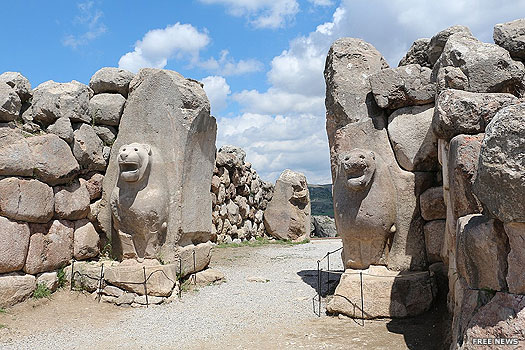 Tarhuntassa's citadel ruins were believed discovered by archaeologists - announced late in 2020 - possibly providing valuable information on this late-appearing Hittite sub-kingdom Tarhuntassa's citadel ruins were believed discovered by archaeologists - announced late in 2020 - possibly providing valuable information on this late-appearing Hittite sub-kingdom |
|
| Egypt attempts to weaken the Hittites (or recognises that they may have ceased to exist as a viable state) by establishing good relations and proposing a diplomatic marriage with Arzawa, as well as requesting some of the Kaskan people of whom the pharaoh has heard. Apparently, Arzawa is strong enough to reach past the Hittites and take Kaskan prisoners for itself. The Hittites under Suppiluliuma eventually manage to destroy the Arzawan fort of Sallapare and retake Tuwanuwa, thought to be on Arzawa's eastern edge. Arzawa also loses its eastern coastal strip of Tarhuntassa at around the same time. However, the state still holds firm elsewhere, commanding territory which seems to be made up of a series of tribal areas according to Hittite documents (it is possible that it always remains this way, as witnessed by the later regional feuding within the state). |
|
|
| c.1350 BC |
During the reign of Suppiluliuma I, the Hittites solidify their control over the south and east of Anatolia. This includes their captured territories in former Kizzuwatna and its western arm, named Tarhuntassa during its relatively brief spell under the control of Arzawa. 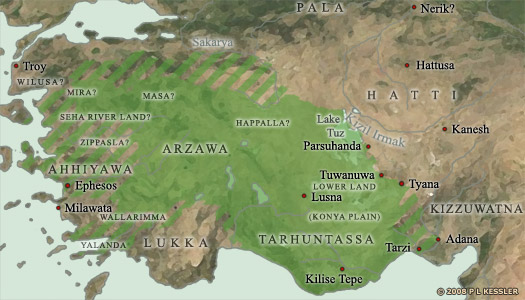 The state of Arzawa existed from at least 1650 BC. By around 1450 BC it controlled the solid green section of the map, which included the state of Tarhuntassa, but probably not the 'Lower Land' (click or tap on map to view full sized) The state of Arzawa existed from at least 1650 BC. By around 1450 BC it controlled the solid green section of the map, which included the state of Tarhuntassa, but probably not the 'Lower Land' (click or tap on map to view full sized) |
|
| c.1300 BC |
Hittite King Muwatalli II moves his capital to the previously obscure city of Tarhuntassa in southern Anatolia (possibly due to the Kaskan sacking of Hattusa). He leaves his brother, the future Hattusili III, in charge of the northern areas, from where he recaptures Hattusa and the cult centre of Nerik, allowing the capital to be returned to the north. |
|
| c.1282 - 1275 BC |
In the north of Anatolia, the future Hattusili III uses his powerbase to undermine current Hittite king, Mursili III, eventually deposing him. He makes Mursili's son, Karunta, 'king of Tarhuntassa' in the south. However, the surviving treaty which refers to Tarhuntassa more often refers to the appointed king as 'Ulmi-Tessup', for which reason some scholars believe that Ulmi-Tessup and Kurunta are two different rulers of Tarhuntassa. 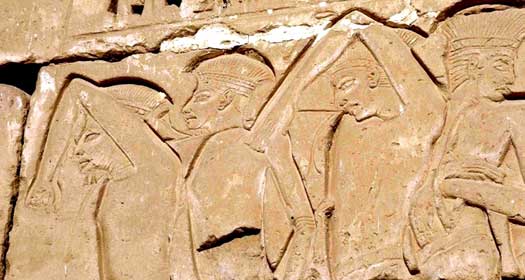 Attacks by the Sea Peoples gathered momentum during the last decade of the thirteenth century BC, quickly reaching a peak which lasted about forty years Attacks by the Sea Peoples gathered momentum during the last decade of the thirteenth century BC, quickly reaching a peak which lasted about forty years |
|
| fl c.1275 BC |
Ulmi-Tessup? |
Senior ruler, or same person as Karunta? |
| c.1275 - 1240? BC |
Karunta / Kuruntiya |
Son of the exiled Mursili III. Hittite sub-king. Junior ruler? |
| c.1241 - 1240 BC |
Karunta may temporarily depose his cousin, Tudhaliya V (IV), but the latter appears to be restored a year later, when he re-ratifies Karunta as king of Tarhuntassa while the latter is at war with Parha. The treaty implies that Tarhuntassa now wields power enough to make it an important player in regional politics, as well as suggesting that it is perhaps only nominally under centralised Hittite control. |
|
| c.1215? BC |
Tarhuntassa attacks the weak Hittite state, but no further details are known. The Hittite king, Suppiluliuma II, is occupied with engaging Alashiya in sea battles as he attempts to invade the Cypriot kingdom. 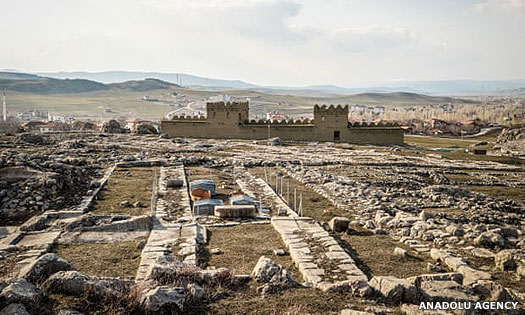 A general view of the ancient city of Hattusa, seemingly destroyed by its own starving people during the Bronze Age collapse, before they moved on to find more habitable locations in which to live A general view of the ancient city of Hattusa, seemingly destroyed by its own starving people during the Bronze Age collapse, before they moved on to find more habitable locations in which to live |
|
| c.1200 BC |
The international system has recently been creaking under the strain of increasing waves of peasants and the poor leaving the cities and abandoning crops. Around the end of this century the entire region is also hit by drought and the loss of surviving crops. Food supplies dwindle and the number of raids by habiru and other groups of peoples who have banded together greatly increases until, by about 1200 BC, this flood has turned into a tidal wave. Already decaying from late in the thirteenth century BC, as [ Assyria](MesopotamiaAssyria.htm#Assyrian Empire) has risen and instability has gripped the Mediterranean coast, the Hittite empire is now looted and destroyed by the Kaskans and the Sea Peoples, and Tarhuntassa disappears from the historical record, also a victim of the regional instability of this period (as noted by [ Egypt](../KingListsAfrica/EgyptAncient.htm#19th Dynasty)). The region is partially occupied by Æolian and Achaean Greeks and becomes known as Pamphylia, while the neo-Hittite state of Que later emerges on its eastern border. 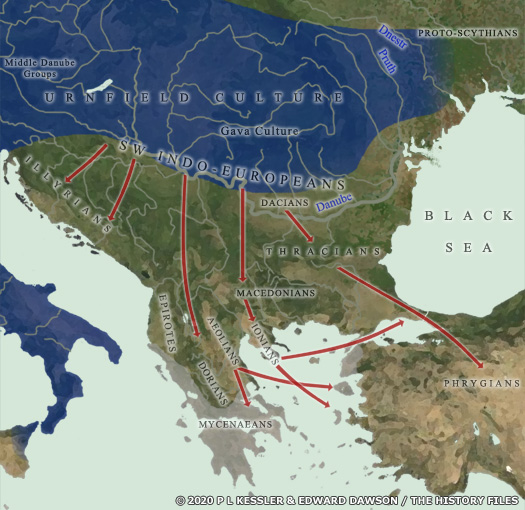 Climate-induced drought in the thirteenth century BC created great instability in the entire eastern Mediterranean region, resulting in mass migration in the Balkans, as well as the fall of city states and kingdoms further east (click or tap on map to view full sized) Climate-induced drought in the thirteenth century BC created great instability in the entire eastern Mediterranean region, resulting in mass migration in the Balkans, as well as the fall of city states and kingdoms further east (click or tap on map to view full sized) |
|
 |
|
|
 Towards the middle days of the New Hittite empire - around the early fourteenth century BC - the Hittites were making useful inroads into the conquest and domination of large swathes of Anatolia which had previously remained independent of them. Largely this involved dominating the western Anatolian state of Arzawa and its host of minor principalities. This West Luwian-speaking state shared its Indo-European origins with the Hittites as part of the South Indo-European group, although its emergence into recorded history in the Near East's sixteenth century BC was somewhat later than recorded Hittite beginnings (see map link). By about 1400 BC the Hittites managed to secure Kizzuwatna, a Luwian state on their southern flank which was even older than theirs. Delayed by various setbacks for the next quarter of a century, it was the late 1370s before they could really turn their attention to Arzawa. Its most vulnerable region seems to have been the recently-captured southern Anatolian coastal area which had become known as Tarhuntassa (or more accurately as Tarḫuntašša) - seemingly bearing the name of Arzawa's current king, Tarhunta-Radu, the 'great king' who expanded the state to its greatest extent. He was clearly becoming a major rival to the Hittites. Tarhuntassa would seem to have been his creation, formed out of several smaller regions which may have been leftovers from Kizzuwatna after its fall. Around 1370 BC Tarhuntassa was seized by the Hittites. They spent the next quarter of a century securing their southern territorial gains, primarily from Arzawa, it seems. By about 1300 BC the Hittite king himself could be found with his capital in Tarhuntassa, having been forced to evacuate Hattusa in the face of the everlasting Kaskan threat. This emergency bolt-hole was in a city of the same name - Tarhuntassa. In the increasingly troubled times of the thirteenth century BC Tarhuntassa increased its separation from the Hittite state even though control of the north had been restored. In the thirteenth century BC it almost became an independent state of its own. To contemporary [ Egyptians](../KingListsAfrica/EgyptAncient.htm#The New Kingdom), Tarhuntassa was known as Kode. It seems that this was inherited from the Egyptian name for Kizzuwatna itself, which was logical enough as Tarhuntassa would probably have formed the entire south-western arm of Kizzuwatna. By the early first millennium BC the same region was known as Kedi or Kode until the fall of the Assyrian empire at the end of the sixth century BC. It is unclear whether this 'foreign' name formed the basis of the name Khilikku which the Greeks mangled into Cilicia. More likely this was a direct descendant of 'Kizzuwatna' itself. To the Luwians and Hittites, Tarhun was the storm god, one of only two of their native gods who had not been replaced or superseded by indigenous Anatolian gods in the time since these South Indo-Europeans had become dominant here. Tarhuntassa was literally 'Tarhun's place'. Like other Luwians, the Arzawans chiefly worshipped Tarhun (also Teshub in Hurrian, later to be replaced in the same role by the Greek Zeus). 'Tarhun' was rendered as 'Tarhunta' in theophoric names. When the Arzawans made treaties with the Hittites, they also called the river and mountain gods to witness. Another element which appears in the personal names is 'Kurunta', often under the Sumerograms KAL and LAMMA. 'Kurunta' alone became a personal name (used at least once by a later prince of Tarhuntassa, around 1275 BC), so it seems likely that Kurunta was a local hero as much as a god (like Heracles to the Greeks). Tarhuntassa's capital had never been discovered by archaeologists - at least until a highly promising announcement in 2020 was able to change that situation. There is little documentary evidence to describe its existence though. Speculation regarding the site of the capital city had included various areas in modern southern Turkey, with perhaps Kilise Tepe ('city of Tarhun') being the favourite.
Towards the middle days of the New Hittite empire - around the early fourteenth century BC - the Hittites were making useful inroads into the conquest and domination of large swathes of Anatolia which had previously remained independent of them. Largely this involved dominating the western Anatolian state of Arzawa and its host of minor principalities. This West Luwian-speaking state shared its Indo-European origins with the Hittites as part of the South Indo-European group, although its emergence into recorded history in the Near East's sixteenth century BC was somewhat later than recorded Hittite beginnings (see map link). By about 1400 BC the Hittites managed to secure Kizzuwatna, a Luwian state on their southern flank which was even older than theirs. Delayed by various setbacks for the next quarter of a century, it was the late 1370s before they could really turn their attention to Arzawa. Its most vulnerable region seems to have been the recently-captured southern Anatolian coastal area which had become known as Tarhuntassa (or more accurately as Tarḫuntašša) - seemingly bearing the name of Arzawa's current king, Tarhunta-Radu, the 'great king' who expanded the state to its greatest extent. He was clearly becoming a major rival to the Hittites. Tarhuntassa would seem to have been his creation, formed out of several smaller regions which may have been leftovers from Kizzuwatna after its fall. Around 1370 BC Tarhuntassa was seized by the Hittites. They spent the next quarter of a century securing their southern territorial gains, primarily from Arzawa, it seems. By about 1300 BC the Hittite king himself could be found with his capital in Tarhuntassa, having been forced to evacuate Hattusa in the face of the everlasting Kaskan threat. This emergency bolt-hole was in a city of the same name - Tarhuntassa. In the increasingly troubled times of the thirteenth century BC Tarhuntassa increased its separation from the Hittite state even though control of the north had been restored. In the thirteenth century BC it almost became an independent state of its own. To contemporary [ Egyptians](../KingListsAfrica/EgyptAncient.htm#The New Kingdom), Tarhuntassa was known as Kode. It seems that this was inherited from the Egyptian name for Kizzuwatna itself, which was logical enough as Tarhuntassa would probably have formed the entire south-western arm of Kizzuwatna. By the early first millennium BC the same region was known as Kedi or Kode until the fall of the Assyrian empire at the end of the sixth century BC. It is unclear whether this 'foreign' name formed the basis of the name Khilikku which the Greeks mangled into Cilicia. More likely this was a direct descendant of 'Kizzuwatna' itself. To the Luwians and Hittites, Tarhun was the storm god, one of only two of their native gods who had not been replaced or superseded by indigenous Anatolian gods in the time since these South Indo-Europeans had become dominant here. Tarhuntassa was literally 'Tarhun's place'. Like other Luwians, the Arzawans chiefly worshipped Tarhun (also Teshub in Hurrian, later to be replaced in the same role by the Greek Zeus). 'Tarhun' was rendered as 'Tarhunta' in theophoric names. When the Arzawans made treaties with the Hittites, they also called the river and mountain gods to witness. Another element which appears in the personal names is 'Kurunta', often under the Sumerograms KAL and LAMMA. 'Kurunta' alone became a personal name (used at least once by a later prince of Tarhuntassa, around 1275 BC), so it seems likely that Kurunta was a local hero as much as a god (like Heracles to the Greeks). Tarhuntassa's capital had never been discovered by archaeologists - at least until a highly promising announcement in 2020 was able to change that situation. There is little documentary evidence to describe its existence though. Speculation regarding the site of the capital city had included various areas in modern southern Turkey, with perhaps Kilise Tepe ('city of Tarhun') being the favourite.
 Tarhuntassa's citadel ruins were believed discovered by archaeologists - announced late in 2020 - possibly providing valuable information on this late-appearing Hittite sub-kingdom
Tarhuntassa's citadel ruins were believed discovered by archaeologists - announced late in 2020 - possibly providing valuable information on this late-appearing Hittite sub-kingdom The state of Arzawa existed from at least 1650 BC. By around 1450 BC it controlled the solid green section of the map, which included the state of Tarhuntassa, but probably not the 'Lower Land' (click or tap on map to view full sized)
The state of Arzawa existed from at least 1650 BC. By around 1450 BC it controlled the solid green section of the map, which included the state of Tarhuntassa, but probably not the 'Lower Land' (click or tap on map to view full sized) Attacks by the Sea Peoples gathered momentum during the last decade of the thirteenth century BC, quickly reaching a peak which lasted about forty years
Attacks by the Sea Peoples gathered momentum during the last decade of the thirteenth century BC, quickly reaching a peak which lasted about forty years A general view of the ancient city of Hattusa, seemingly destroyed by its own starving people during the Bronze Age collapse, before they moved on to find more habitable locations in which to live
A general view of the ancient city of Hattusa, seemingly destroyed by its own starving people during the Bronze Age collapse, before they moved on to find more habitable locations in which to live Climate-induced drought in the thirteenth century BC created great instability in the entire eastern Mediterranean region, resulting in mass migration in the Balkans, as well as the fall of city states and kingdoms further east (click or tap on map to view full sized)
Climate-induced drought in the thirteenth century BC created great instability in the entire eastern Mediterranean region, resulting in mass migration in the Balkans, as well as the fall of city states and kingdoms further east (click or tap on map to view full sized)